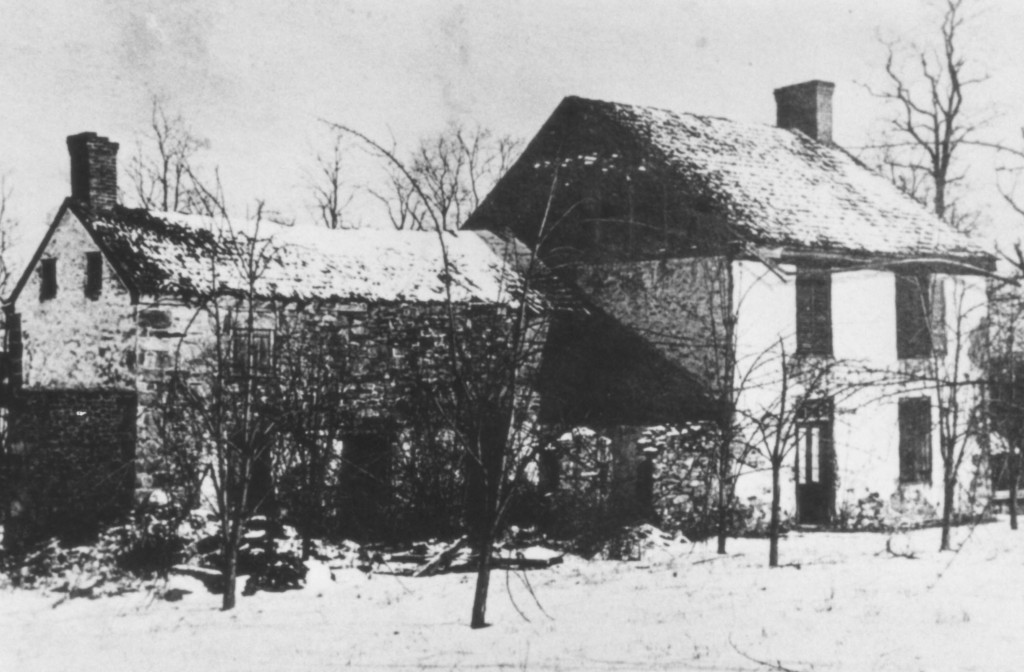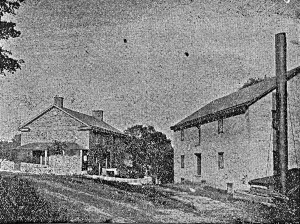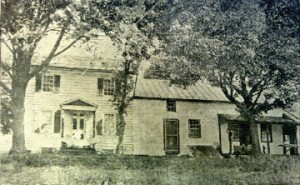Fifty years ago, on September 15, 1961, the “reconstructed” covered bridge was dedicated. An alert reporter at the Star Ledger, Mike Frassinelli, reminded me of this fact, and that inspired me to reprint an article I wrote for “The Bridge,” the newsletter for Delaware Township, back in 2001, and also in the Hunterdon Historical Newsletter, Fall 2003 issue.
Opdycke
OPDYCKE. Also Opdyke or Updyke. The first of this family in Hunterdon was John Opdycke (1710-1777) and his wife Margaret Green (1711-1775), daughter of Samuel Green. For a time, they owned much of the land around Headquarters, as well as the farm where the covered bridge now stands. Their children and descendants became prominent in Hunterdon history.
Washington’s Headquarters, Raritan Township, 1777
by Jonathan M. Hoppock
Democrat-Advertiser, 26 September 1901
The above view of this old mansion now standing on the farm of Manning Dilts in Raritan Township, at the top of what is known as Buchanan’s or Dilley’s Hill, built in 1725, making it one hundred and seventy-six years old, was recently photographed by Mr. J. C. Sunderlin of Flemington.1 From this elevation the eye has a view of the Raritan valley as far east as Bound Brook. Also from this point a view can be had of the Sourland Mountain range from the Delaware on the west, extending through the counties of Hunterdon and Somerset, presenting to the view a greater scope of country than can probably be seen from any other point in the county.
White Hall Recruiting Station, 1775-1781
by Jonathan M. Hoppock
Democrat-Advertiser, 24 October 1901

This old building, erected in 1758 at Head Quarters, now Grover, standing on the corner of the road on the farm at present owned by Smith Skinner, was, between the dates given above, used as a recruiting station.1 As shown by papers in possession of the writer, Captain David Jones, of the Continental line, was the recruiting officer, and at this point, when the alarm was given that the then hated minions of King George had made a landing at Paulus Hook (Jersey City) or Amboy, would assemble the patriotic old citizen-soldiery, armed with the flint-locks, home-made bullets and powder horns, and from thence hasten to the front to assist the great Washington in beating back the invaders.2
Washington’s Headquarters, July 1777
Washington Didn’t Sleep in Delaware Twp.
And he probably didn’t visit either. But the notion that he spent a leisurely afternoon drinking fresh water under a shady tree in the company of John Opdycke just won’t go away. It probably never will.
J. M. Hoppock: The Old Opdyke House
Benjamin Tyson’s Mill
Mr. Bush is seldom wrong but in this case the headline writer and Mr. Bush were both mistaken about disclosing the location of Tyson’s Mill, but certainly correct about the meagerness of the old records. For my version of this mill’s history, see Tyson’s Mill at Headquarters.
Tyson’s Mill at Headquarters
Modified from part of an article first published in The Delaware Township Post, July 21, 2006, as “A History of Headquarters Mill.”
John Opdycke sold Headquarters Mill to Joseph Howell in 1763, at the end of the French and Indian War. This was probably a shrewd decision on Opdycke’s part, since demand for flour would certainly drop off with the end of the war.
Who Saw George Washington?
The question of whether Washington actually visited Headquarters has bedeviled local historians for decades. The source of the controversy was Fanny Carrell, who was interviewed by Charles W. Opdycke, for his well-known Opdyke Genealogy sometime around 1880 [pg 218-19]. Frances ‘Fanny’ Opdycke was the wife of James Carrell, and he was the grandson of Elizabeth Opdycke Arnwine, daughter of old John Opdycke Esq.
“Headquarters” Has Two Buildings of Historic Interest
Mill and Mansion Built at Time of French and Indian War
Name “Grover” Never Stuck
by Egbert T. Bush, Stockton, N.J
Hunterdon County Democrat, November 7, 1929
While the mother countries and their colonies were scouring rifles and picking flints in preparation for that spectacular game in the Noble Sport of kings, known to us as the French and Indian War, humble workers whose names are all forgotten were quietly engaged in shaping stones, pouring mortar and cutting “B. 1754” into the date stone for a gristmill six miles west of Flemington.


